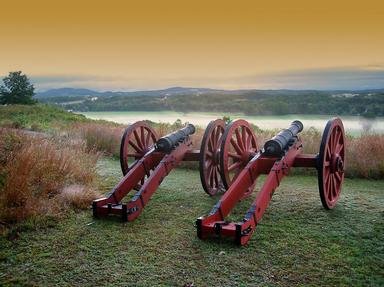Quiz Answer Key and Fun Facts
1. I Wish I Was in Western Virginia, General Lee's first campaign in Confederate uniform. Well, this one was certainly not his best. Lee had to cope with mountain, rain, numerous Union troops, disaffected volunteers and incompetent subordinates. The principal engagement was Cheat Mountain, where Lee was, under the orders of CSA President Jefferson Davis, supervising the Army of the Northwest. This frustrated the original commander of the force. Who was he?
2. I Wish I Was in the Seven Days, the climax of the Peninsula Campaign and where General Lee first commanded the Army of Northern Virginia. Since Lee's aim was to drive the Union Army of the Potomac away from the Confederate capital of Richmond, he needed conduct an offensive campaign. Given that, and Lee's aggressive style in command, it's easy to assume that the Seven Days were, from start to finish, a Confederate offensive. While this applies to the bulk of the battles of that campaign, in one of them Lee's soldiers were on the defensive. What is the battle's name?
3. I Wish I Was at Second Manassas (Bull Run), the culmination of the Northern Virginia Campaign. There, General Lee and the Army of Northern Virginia utterly defeated John Pope and his newly given command. Pope, apart from being an inept and careless commander was the adversary Lee disliked most. How did Lee style Pope?
4. I Wish I Was at Sharpsburg (Antietam), where General Lee and the Army of Northern Virginia fiercely resisted repeated attacks by the Union Army of the Potomac commanded by George McClellan. It was there that the phrase "And then A.P. Hill came up" was first used, because Hill arrived in the nick of time to prevent the collapse of the Confederate lines, in fact saving them from the Union onslaught. Where was Hill before setting out to reach Lee at Sharpsburg?
5. I Wish I Was in Fredericksburg, where General Lee and the Army of Northern Virginia inflicted another severe defeat on the Army of the Potomac, this time commanded by Ambrose Burnside. The Fredericksburg Campaign was one of the most lopsided in the whole course of the war. Which of the following facts about the battle is NOT true?
6. I Wish I Was at Chancellorsville, the battle widely known as General Lee's "perfect battle". There, the Army of the Potomac under Joseph Hooker suffered a stunning defeat. Yet the biggest part of the First Corps of the Army of Northern Virginia, including its commander, James Longstreet, was not present, since it was detached in another part of Virginia. Only two divisions were present at Chancellorsville. Who were the commanders of those divisions?
7. I Wish I Was at Gettysburg, perhaps the most famous battle of the entire war. Although Gettysburg cannot be described as a Confederate victory, the Army of Northern Virginia emerged as the winner on the first day and gained ground on the second. Which of the following statements about Gettysburg is NOT true?
8. I Wish I Was in the Overland Campaign, where General Lee and the Army of Northern Virginia were pitted against a new adversary, Ulysses S. Grant. The obstacles Lee had to face were Union numerical superiority, relentless activity by his opponent and, in one part of the campaign, illness. With what illness was General Lee plagued with during a phase of the Overland Campaign?
9. I Wish I Was in Petersburg, the last citadel. General Robert E. Lee and the Army of Northern Virginia are defending the cities of Petersburg and Richmond against the Union Army of the Potomac, led by Ulysses S. Grant. While most battles of this campaign occurred in 1864, there were some fought in the first three months of 1865. Which of the following battles in the Petersburg Campaign was fought in 1865?
10. I Wish I Was in Dixie to try the Robert E. Lee cake. Apart from being a celebrated and admired military commander, General Lee has not inspired only soldiers and generals, but other groups of people like chefs. What are the two main ingredients of the Robert E. Lee cake?
Source: Author
DeepHistory
This quiz was reviewed by FunTrivia editor
bloomsby before going online.
Any errors found in FunTrivia content are routinely corrected through our feedback system.
